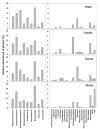Pyrosequencing enumerates and contrasts soil microbial diversity
- PMID: 18043639
- PMCID: PMC2970868
- DOI: 10.1038/ismej.2007.53
Pyrosequencing enumerates and contrasts soil microbial diversity
Abstract
Estimates of the number of species of bacteria per gram of soil vary between 2000 and 8.3 million (Gans et al., 2005; Schloss and Handelsman, 2006). The highest estimate suggests that the number may be so large as to be impractical to test by amplification and sequencing of the highly conserved 16S rRNA gene from soil DNA (Gans et al., 2005). Here we present the use of high throughput DNA pyrosequencing and statistical inference to assess bacterial diversity in four soils across a large transect of the western hemisphere. The number of bacterial 16S rRNA sequences obtained from each site varied from 26,140 to 53,533. The most abundant bacterial groups in all four soils were the Bacteroidetes, Betaproteobacteria and Alphaproteobacteria. Using three estimators of diversity, the maximum number of unique sequences (operational taxonomic units roughly corresponding to the species level) never exceeded 52,000 in these soils at the lowest level of dissimilarity. Furthermore, the bacterial diversity of the forest soil was phylum rich compared to the agricultural soils, which are species rich but phylum poor. The forest site also showed far less diversity of the Archaea with only 0.009% of all sequences from that site being from this group as opposed to 4%-12% of the sequences from the three agricultural sites. This work is the most comprehensive examination to date of bacterial diversity in soil and suggests that agricultural management of soil may significantly influence the diversity of bacteria and archaea.
Figures




References
-
- Aref S, Wander MM. Long-term trends of corn yield and soil organic matter in different crop sequences and soil fertility treatments on the Morrow Plots. Adv Agron. 1998;62:153–202.
-
- Baker GC, Smith JJ, Cowan DA. Review and reanalysis of domain-specific 16S primers. J Microbiol Methods. 2003;55:541–555. - PubMed
-
- Felsenstein J. PHYLIP—Phylogeny Inference Package (Version 3.2) Cladistics. 1989;5:164–166.

